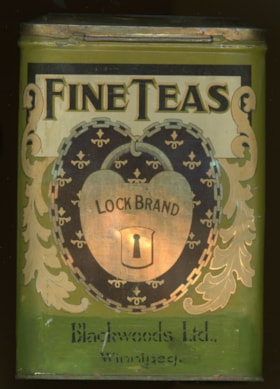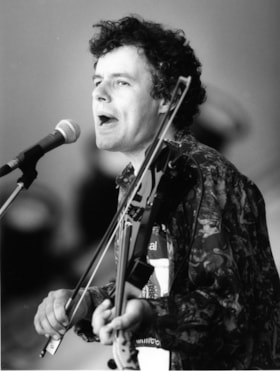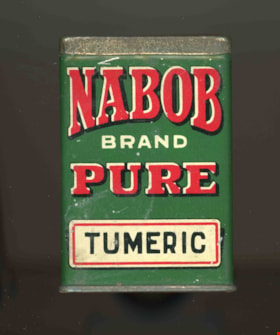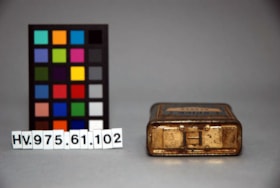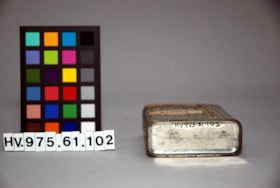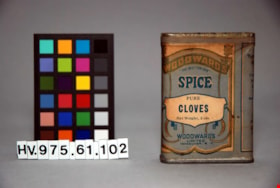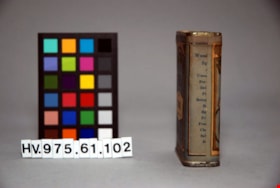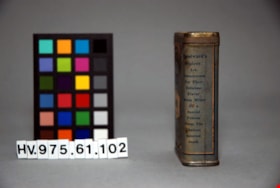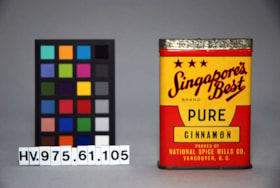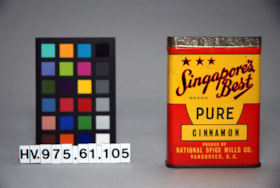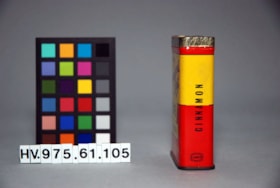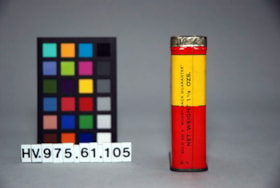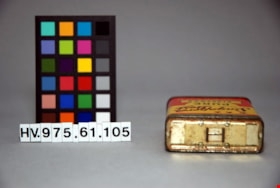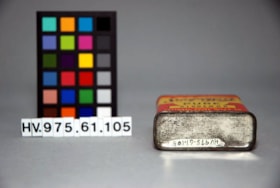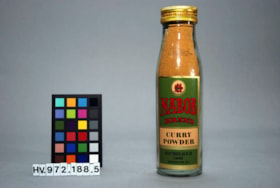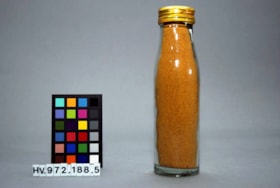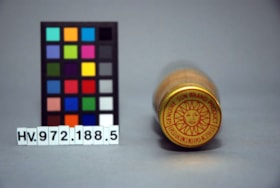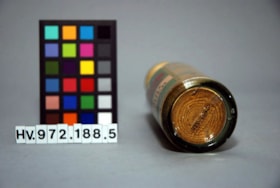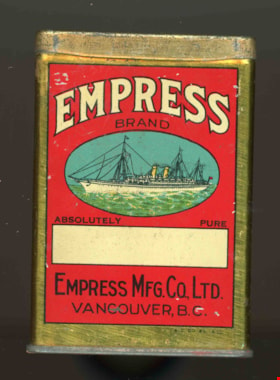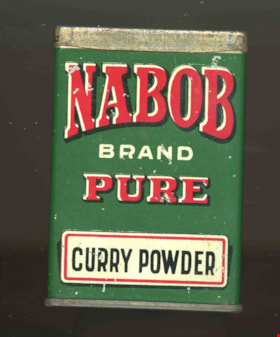Narrow Results By
Decade
- 2020s 5
- 2010s 5
- 2000s 7
- 1990s 7
- 1980s 6
- 1970s 5
- 1960s 4
- 1950s 5
- 1940s 3
- 1930s 2
- 1920s 2
- 1910s 2
- 1900s 4
- 1890s 2
- 1880s 1
- 1870s 1
- 1860s 1
- 1850s 1
- 1840s 1
- 1830s 1
- 1820s 1
- 1810s 1
- 1800s 1
- 1790s 1
- 1780s 1
- 1770s 1
- 1760s 1
- 1750s 1
- 1740s 1
- 1730s 1
- 1720s 1
- 1710s 1
- 1700s 1
- 1690s 1
- 1680s 1
- 1670s 1
- 1660s 1
- 1650s 1
- 1640s 1
- 1630s 1
- 1620s 1
- 1610s 1
- 1600s 1
The a.b.c. of spice cookery
https://search.heritageburnaby.ca/link/museumlibrary5522
- Repository
- Burnaby Village Museum
- Collection
- Special Collection
- Material Type
- Book
- Accession Code
- BV002.65.10
- Call Number
- 641.59 LAN
- Contributor
- Lane, Betty
- Place of Publication
- New York
- Publisher
- American Spice Trade Association
- Publication Date
- c1950
- Physical Description
- 48 p. : ill. ; 20 cm.
- Library Subject (LOC)
- Cooking
- Spices
- Cookbooks--1950-1959
- Notes
- Includes index.
- "Recipe supervision: Fritzi Swanstrom"-title page
- "price: twenty-five cents"-cover page
Burnaby centennial anthology : stories of early Burnaby
https://search.heritageburnaby.ca/link/museumlibrary5472
- Repository
- Burnaby Village Museum
- Edition
- Rev. ed.
- Publication Date
- 1994
- Call Number
- 971.133 BUR COPY 3
- Repository
- Burnaby Village Museum
- Collection
- Digital Reference Collection
- Material Type
- Book
- ISBN
- 0969282826
- Call Number
- 971.133 BUR COPY 3
- Edition
- Rev. ed.
- Place of Publication
- Burnaby, B.C.
- Publisher
- City of Burnaby
- Publication Date
- 1994
- Physical Description
- 531 p. : ill. ; 28 cm.
- Library Subject (LOC)
- Burnaby (B.C.)--History
- Burnaby (B.C.)
- Biography
- Notes
- Includes index.
- 3 copies held: copy 3.
Digital Books
In the shadow by the sea : recollections of Burnaby's Barnet Village
https://search.heritageburnaby.ca/link/museumlibrary5173
- Repository
- Burnaby Village Museum
- Collection
- Digital Reference Collection
- Reference Collection
- Material Type
- Book
- ISBN
- 0969282885
- Call Number
- 971.133 PRI Copy 2
- Contributor
- Wolf, Jim
- Pride, Harry, 1925-
- Place of Publication
- Burnaby, B.C.
- Publisher
- City of Burnaby
- Publication Date
- c2004
- Physical Description
- 246 p. : ill., maps, ports. ; 28 cm.
- Library Subject (LOC)
- Burnaby (B.C.)--History
- Industries--British Columbia--Burnaby--History
- Barnet Marine Park--Burnaby, B.C.
- Geographic Access
- Barnet Road
- Burrard Inlet
- Notes
- Includes bibliographical references (p. 246) and index.
- "edited by Harry Pride and Jim Wolf"
- Copy 2 of 2
Digital Books
Pioneer tales of Burnaby
https://search.heritageburnaby.ca/link/museumlibrary5860
- Repository
- Burnaby Village Museum
- Collection
- Digital Reference Collection
- Reference Collection
- Material Type
- Book
- ISBN
- 096928280x
- Call Number
- 971.133 SON COPY 4
- Contributor
- Sone, Michael
- Place of Publication
- Burnaby, B.C.
- Publisher
- Corporation of the District of Burnaby
- Publication Date
- c1987
- Physical Description
- 495 p. : ill. ; 31 cm.
- Inscription
- "TR687 - Bryburgh" / handprinted in pencil on frontend page
- Library Subject (LOC)
- Pioneers--British Columbia--Burnaby
- Frontier and pioneer life
- Biography
- Object History
- Early Burnaby as recalled by the settlers themselves who arrived from every corner of the world between 1888 and 1930, some witnessing incorporation of the district in 1892, all seeking a better life for themselves and especially for their children, all helping transform the wilderness into the modern municipality of today.
- Notes
- "Editor Michael Sone".
- Includes index.
- 4 copies held: copy 4
Images
Digital Books
Interview with Prem Kaur Gill, Santokh Singh Gill and Mohinder Kaur Gill
https://search.heritageburnaby.ca/link/museumdescription19347
- Repository
- Burnaby Village Museum
- Date
- [1957-2022] (interview content), interviewed 11 Nov. 2022
- Collection/Fonds
- Burnaby Village Museum fonds
- Description Level
- Item
- Physical Description
- 1 sound recording (m4a) (118 min., 39 sec.) + 1 sound recording (mp3) (115 min., 20 sec.)
- Scope and Content
- Item consists of an oral history interview with Santokh "Gurmail" Singh Gill and Mohinder Kaur Gill and their daughter, Prem Kaur Gill conducted by interviewers, Anushay Malik and Rajdeep. The interview is conducted in English, Punjabi, Hindi and Urdu. The three members of the Gill family share the…
- Repository
- Burnaby Village Museum
- Collection/Fonds
- Burnaby Village Museum fonds
- Series
- Museum Oral Histories series
- Description Level
- Item
- Physical Description
- 1 sound recording (m4a) (118 min., 39 sec.) + 1 sound recording (mp3) (115 min., 20 sec.)
- Material Details
- Interviewers: Anushay Malik, Rajdeep Interviewees: Prem Kaur Gill, Santokh "Gurmail" Singh Gill and Mohinder Kaur Gill Location of Interview: Gill family residence on Warwick Avenue in Burnaby Interview Date: November 11, 2022 Total Number of tracks: 1 Total Length of all Tracks: (1:58:39) Digital master recording (m4a) was converted to mp3 for access on Heritage Burnaby
- Scope and Content
- Item consists of an oral history interview with Santokh "Gurmail" Singh Gill and Mohinder Kaur Gill and their daughter, Prem Kaur Gill conducted by interviewers, Anushay Malik and Rajdeep. The interview is conducted in English, Punjabi, Hindi and Urdu. The three members of the Gill family share their ancestral background, their personal experiences immigrating to Canada, living in Burnaby and working in British Columbia as South Asian immigrants. 00:00 – 27:34 Santokh “Gurmail” Singh Gill and Mohinder Kaur Gill share their migration stories and experiences living and working in British Columbia as South Asian immigrants and their eldest child, Prem Kaur Gill shares her own experiences as a child of South Asian immigrants and growing up in British Columbia as a South Asian Canadian. Gurmail Singh Gill was born in the District of Jalandhar and Mohinder Kaur Gill was born in Hoshiapur of the Indian state of Punjab. Gurmail describes how he moved from India to England with his family in 1957, immigrated to Canada from England in 1966, married his wife Mohinder in England in 1968 and brought his family (parents and two siblings) to Canada from England in 1970 and other relatives including his wife’s family in the 1970s and 1980s. Mohinder and Gurmail Gill recollect their arranged marriage in England in 1968, their immigration process and explain how they arrived in Burnaby residing with a cousin at 4649 Georgia Street until they were able to purchase their own home after a few years. Gurmail shares names and connections to the relatives that came to British Columbia before him. Gurmail and Mohinder tell how they lived in the basement of the house and rented out the upper floor to save money. The couple recall what they brought with them when they immigrated to Canada and Mohinder Kaur Gill tells of how before leaving India, she and her mother made a special rajai for her to take with her. Mohinder describes the process of making a rajai (a quilted blanket that was made by hand). Gurmail and Mohinder Gill talk about the challenges that they’ve experienced as new immigrants including not being fluent in English, the cold weather and not having very many family or friends nearby to provide support. They attended the Gurdwara on Ross Street or Akali Singh Sikh Society Gurdwara on Skeena in Vancouver. They explain how there was limited access to grocery stores that supplied Punjabi and Indian spices and other cooking supplies. They talk about how they used a food mill and mortar and pestle to grind their own spices and flour and how Mohinder often made traditional sweets like barfi and laddo and pakoras using pea flour when they couldn’t get Besan flour. 27:35 – 36:11 Gurmail provides more details on his family’s immigration story, including names of relatives, how his six siblings and parents all immigrated to British Columbia in 1970 and how in the early 1970s and mid 1980’s Gurmail and his family sponsored approximately 70 friends and relations from India (including Mohinder’s family) to immigrate to Canada. When Mohinder’s family arrived they lived with them in their house until they were able to purchase property next door and build their own home. Children in the families all attended elementary and high school in Burnaby which now amounts to three generations. 36:12 – 59:28 Gurmail and Mohinder Gill talk about their experiences of racial discrimination. Gurmail recalls members of the South Asian community, Dr. Hari Prakash Sharma, Harinder Mahil and Charan Gill starting the British Columbia Organization to Fight Racism. Gurmail tells of how he got involved contributing some of his union dues as a member of CAIMAW (Canadian Association of Industrial Mechanical and Allied Workers Union- Local 15) and as a friend of Charan Gill and Raj Chouhan of the Canadian Farm Workers Union. Gurmail Gill explains how he was a founding member of CAIMAW and treasurer until the union merged with the Canadian Auto Workers Union (in 1991). Mohinder and Gurmail tell of how people from the South Asian community were discouraged from wearing Punjabi dresses or head coverings for fear of being yelled at with racial slurs and how it was often scary to go outside. Many from their community often avoided attending the Akali Singh Gurdwara since a head covering was required and people were afraid of being a target. Gurmail provides details about his work with A1 Steel, how different unions were formed pertaining to various skillsets and jobs per company and how he became a member of CAIMAW Local 15 (foundry workers). Mohinder recollects her experiences as a mother, the daily tasks involved and friends that she made who’d also emigrated from Punjab. Mohinder describes how she designed and sewed many Punjabi dresses using her electric sewing machine and how she learned English by attending adult classes at a church on Commercial Drive. Mohinder and her mother attended the classes for two hours per day for six years at a cost of twelve dollars for ten weeks. Once Mohinder could speak a little English, she started working and was able to practice more. 59:29 – 1:06:08 Mohinder, Gurmail and Prem talk about some of their favourite traditional foods including corn roti and spinach curry and how they grow many of their own vegetables including peppers, eggplant, saag (spinach), onions, garlic, cilantro, zucchini, squash and fenugreek. Mohinder reflects on how access to Punjabi clothing and fabric stores in Vancouver has changed and that ready made food is now more available. Traditional foods were previously made from scratch with women gathering together and cooking for hours and now it’s gotten easier but more expensive and less of a community feel. 1:06:09- 1:55:20 Mohinder and Gurmail Gill discuss and share their perspectives and experiences on raising a family in the past versus today. Gurmail imparts that all of his siblings became educated and secured professional careers while he continued to work in the trades. Prem Kaur Gill shares her own experiences growing up and attending school in Burnaby. Gurmail and Mohinder Gill recall the type of suitcase that they brought with them when they immigrated and how they recently they got rid of it. Gurmail and the group reflect and discuss the confusion with racial identity terms that have been used in this country. They comment that South Asians were referred to as “Hindu” and “East Indian” and Indigenous peoples were referred to as “Indian” and the controversy and racism behind some of these terms. The group discusses the impact of the caste system and other discriminatory experiences and compare their experiences of living in England to living in Canada. Prem comments on how it’s just recently that South Asian customs, celebrations and practices have been recognized and celebrated here in Canada, like Diwali and yoga. They comment on how much of the language, culture and customs have been retained in Surrey where many can still communicate in Punjabi and don’t need to be fluent in English. The group discusses how many South Asians immigrants first lived and worked in Vancouver but with rising property prices many moved to Surrey expanding and establishing a much larger South Asian community with resources. The group discusses and compares the differing travel routes that many of them and their relatives took when immigrating and travelling between India and Canada. The group talks about Rajdeep’s ancestral village in India which is near the Gill village of Firozpur. Gurmail explains the origins and details behind his family name that was changed from “Shergill” to “Gill” and the name “Santokh” from his maternal side.
- History
- Interviewees' biographies: Santokh "Gurmail" Singh Gill was born in the District of Jalandhar in Punjab, India. Gurmail moved to England with his family in 1957 and immigrated to British Columbia in 1966. Gurmail married his wife, Mohinder Kaur Gill in England in 1968 and she immigrated to British Columbia from England soon after. Gurmail first lived with a cousin in Burnaby before purchasing a home of his own in Burnaby where he raised his family. Gurmail worked in the steel industry and was a member and treasurer of the CAIMAW before the union merged with the Canadian Auto Workers Union. Mohinder Kaur Gill was born in the Hoshiapur in Punjab, India. She married her husband Santokh "Gurmail" Singh Gill in England in 1968 and immigrated to Burnaby, British Columbia to join her husband. Mohinder and Gurmail Gill have four children, all born in Burnaby. Prem Kaur Gill was born in Burnaby in 1969 and is the eldest child of Santokh "Gurmail" Singh Gill and Mohinder Kaur Gill. Prem grew up and attended school in Burnaby. Interviewers' biographies: Anushay Malik is labor historian with a geographical focus on South Asia. Anushay studied at the University of London and was a research fellow at the International Institute of Social History in Amsterdam, Netherlands. In 2014, Anushay moved back to her native Pakistan and joined Lahore University of Management Services as an Assistant Professor. In 2023, Anushay is a visiting scholar at Simon Fraser University and lives in Burnaby with her family. Anushay was a co-curator of the Burnaby Village Museum exhibit “Truths Not Often Told: Being South Asian in Burnaby”. Rajdeep was born and raised in the Lower Mainland and is of Punjabi (South Asian) descent. She has an Associate of Arts degree in Asian Studies from Kwantlen Polytechnic University, a Bachelor of Arts (Hons.) in Anthropology from the University of British Columbia. She is a student in the Restoration of Natural Systems program at the University of Victoria. Rajdeep works at Simon Fraser University as a Program Assistant and as a researcher with the City of Burnaby. At Burnaby Village Museum, Rajdeep contributed to the exhibit “Truths Not Often Told: Being South Asian in Burnaby”.
- Creator
- Burnaby Village Museum
- Subjects
- Clothing
- Foods
- Indigenous peoples
- Buildings - Religious - Temples
- Food Processing Tools and Equipment
- Persons - South Asian Canadians
- Social Issues
- Social Issues - Racism
- Migration
- Occupations
- Organizations - Unions
- Responsibility
- Rajdeep
- Malik, Anushay
- Accession Code
- BV022.29.2
- Access Restriction
- No restrictions
- Reproduction Restriction
- No known restrictions
- Date
- [1957-2022] (interview content), interviewed 11 Nov. 2022
- Media Type
- Sound Recording
- Notes
- Title based on contents of item
- Transcript available upon request - contact Burnaby Village Museum
- Indian Family System Reference notes: Baba = informal way to say grandfather; old man Bibi = informal way to say grandmother; old woman Dada= paternal grandfather Dadi= paternal grandmother Dadke= paternal family members; paternal side (Various spellings might exist for the following terms) Thaiyya= father’s elder brother (uncle) Thaiyyi= father’s elder brother’s wife (aunt) Chacha= father’s younger brother (uncle) Chachi= father’s younger brother’s wife (aunt) Bua= father’s sister (older or younger) (aunt) Phuphar= father’s sister’s husband (uncle) Nana= maternal grandfather Nani= maternal grandmother Nanke/nanka= maternal family members; maternal side Mama= mom’s brother (older or younger) (uncle) Mami= mom’s brother’s wife (aunt) Maasi= mom’s sister (older or younger) (aunt) Maasard= mom’s sister’s husband (uncle)
Audio Tracks
Interview with Prem Kaur Gill, Santokh Singh Gill and Mohinder Kaur Gill, [1957-2022] (interview content), interviewed 11 Nov. 2022
Interview with Prem Kaur Gill, Santokh Singh Gill and Mohinder Kaur Gill, [1957-2022] (interview content), interviewed 11 Nov. 2022
https://search.heritageburnaby.ca/media/hpo/_Data/_BVM_Sound_Recordings/Oral_Histories/2022_0029_0002_002.mp3Blue ribbon cookbook : for everyday use in Canadian homes
https://search.heritageburnaby.ca/link/museumlibrary461
- Repository
- Burnaby Village Museum
- Author
- Blue Ribbon
- Edition
- Rev. ed.
- Publication Date
- 1905
- Call Number
- 641 BLU
- Repository
- Burnaby Village Museum
- Collection
- Special Collection
- Material Type
- Book
- Accession Code
- BV987.16.1
- Call Number
- 641 BLU
- Edition
- Rev. ed.
- Author
- Blue Ribbon
- Place of Publication
- Winnipeg, Canada
- Publisher
- Blue Ribbon Manufacturing
- Publication Date
- 1905
- Physical Description
- 144 p., [30] p. : ill (some col.)
- Inscription
- [Extensive handwritten recipes on 10 p. including inside covers, back and front leaves and end papers, in blue and green ink as well as pencil]
- Library Subject (LOC)
- Cooking, Canadian
- Cookbooks--1900-1909
- Notes
- "G.F. 7 J. GALT LIMITED Manufacturers and Packers of Blue Ribbon Tea, Coffee, Baking Powder, Extracts, Spices, etc" -- Subtitle page
- Includes index
Blue ribbon cookbook : prepared especially for everyday use in Western homes
https://search.heritageburnaby.ca/link/museumlibrary417
- Repository
- Burnaby Village Museum
- Author
- Blue Ribbon
- Edition
- Rev. ed.
- Publication Date
- 1905
- Call Number
- 641.5 BLU
- Repository
- Burnaby Village Museum
- Collection
- Special Collection
- Material Type
- Book
- Accession Code
- BV988.44.6
- Call Number
- 641.5 BLU
- Edition
- Rev. ed.
- Author
- Blue Ribbon
- Place of Publication
- Winnipeg, Canada
- Publisher
- Blue Ribbon Manufacturing
- Publication Date
- 1905
- Physical Description
- 157 p. : ill. (some col) ; 17 cm.
- Inscription
- "C.J. Caunt Jan 27/25 Vancouver, B.C." [Handwritten, black ink on front leaf, centre.]
- Library Subject (LOC)
- Cooking, Canadian
- Cookbooks--1900-1909
- Notes
- "BLUE RIBBON LIMITED Manufacturers and Packers of Blue Ribbon Tea, Coffee, Baking Powder, Extracts, Spices, etc" -- Subtitle page
- Includes index
box
https://search.heritageburnaby.ca/link/museumartifact45122
- Repository
- Burnaby Village Museum
- Accession Code
- BV002.78.21
- Description
- Box, metal, hinged lid; green, gold, brown, ivory, black; on front and back, padlock and chain heart-shaped design, leaves either side; "Fine Teas" "Lock Brand" "Blackwoods Ltd., Winnipeg"; on two sides, "The Dyson Co. Direct Importers and Blenders of Lock Brand Teas and Manufacturers of Red Cross Brand" "Trade Mark Registered" "Coffee and Spices" "Baking Powder..." "Winnipeg"; rust, metal deterioration
- Object History
- Donor purchased objects from various collectors and antique retailers.
- Measurements
- 175mm X 120mm X 225mm
Images
Crawfish Fiesta
https://search.heritageburnaby.ca/link/archivedescription81135
- Repository
- City of Burnaby Archives
- Date
- July 29, 1998
- Collection/Fonds
- Burnaby NewsLeader photograph collection
- Description Level
- Item
- Physical Description
- 1 photograph : b&w ; 21 x 15.5 cm
- Scope and Content
- Photograph of a member of the musical group “Crawfish Fiesta” performing at Discovery Day.
- Repository
- City of Burnaby Archives
- Date
- July 29, 1998
- Collection/Fonds
- Burnaby NewsLeader photograph collection
- Physical Description
- 1 photograph : b&w ; 21 x 15.5 cm
- Description Level
- Item
- Record No.
- 535-1283
- Access Restriction
- No restrictions
- Reproduction Restriction
- No reproduction permitted
- Accession Number
- 2012-11
- Scope and Content
- Photograph of a member of the musical group “Crawfish Fiesta” performing at Discovery Day.
- Subjects
- Occupations - Musicians
- Media Type
- Photograph
- Photographer
- Bartel, Mario
- Notes
- Title based on contents of photograph
- Note in blue ink on recto of photograph reads: "Bby Bartel 1606 B / 48% Bby p. 11"
- Trim marks and/or reproduction instructions on recto (scan is cropped)
- Accompanying caption reads: "July 29, 1998 1606 B: / There was much to see and do at this year's Discovery Day in Burnaby on Saturday. Loads of entertainment and lots of fun for the ids kept Deer Lake Park hopping into the evening. Crawfish Fiesta spices up the Rogers Cablesystems Main Stage."
Images
Interview with Kalwant Singh "Nadeem" Parmar
https://search.heritageburnaby.ca/link/museumdescription19346
- Repository
- Burnaby Village Museum
- Date
- [1600-2022] (interview content), interviewed 7 Oct. 2022
- Collection/Fonds
- Burnaby Village Museum fonds
- Description Level
- Item
- Physical Description
- 2 sound recordings (wav) (111 min., 51 sec.) + 1 sound recording (mp3) (111 min., 51 sec.)
- Scope and Content
- Item consists of a recording of an oral history interview with Kalwant Singh "Nadeem" Parmar conducted by interviewers, Anushay Malik and Rajdeep with assistance from Burnaby Village Museum Assistant Curator, Kate Petrusa. During the interview Kalwant Singh "Nadeem" Parmar discusses and provides in…
- Repository
- Burnaby Village Museum
- Collection/Fonds
- Burnaby Village Museum fonds
- Series
- Museum Oral Histories series
- Description Level
- Item
- Physical Description
- 2 sound recordings (wav) (111 min., 51 sec.) + 1 sound recording (mp3) (111 min., 51 sec.)
- Material Details
- Interviewers: Anushay Malik, Rajdeep Co Interviewer and technical support: Kate Petrusa Interviewee: Nadeem Parmar Location of Interview: Residence of Nadeem Parmar in Burnaby Interview Date: October 7, 2022 Total Number of tracks: 2 Total Length of all Tracks: 01:51:51 min Digital master recordings (wav) were recorded onto two separate audio tracks, edited and merged together and converted to mp3 for access on Heritage Burnaby
- Scope and Content
- Item consists of a recording of an oral history interview with Kalwant Singh "Nadeem" Parmar conducted by interviewers, Anushay Malik and Rajdeep with assistance from Burnaby Village Museum Assistant Curator, Kate Petrusa. During the interview Kalwant Singh "Nadeem" Parmar discusses and provides information on; his ancestral background, his education, his employment background, his experiences of racial discrimmination as a South Asian immigrant, saw mills established by South Asian relations in Paldi (Vancouver Island), in North Vancouver and Burnaby, family relations in the South Asian Canadian community and in regions in Punjab, the caste system, his literary works, locations of family homes in Burnaby, the architectural design of his house, personal stories and anecdotal information as a South Asian Canadian living and working in Canada. 00:00 – 01:45 The framework and purpose of the interview is explained to interviewee Nadeem Parmar by interviewers Rajdeep and Anushay Malik. The interviewers explain how the information from this interview can be drawn on for Burnaby Village Museum’s future exhibits and also how researchers will learn more about the history of the South Asian community in Burnaby through residents’ stories. Interview begins with Nadeem providing his full name "Kulwant Singh Parmar". He clarifies that his name was given to him by his grandfather who was a civil engineer and that his father also worked as a civil engineer. Nadeem expresses that he was born with a “silver spoon in his mouth” as a descendent of his maternal grandfather who was a successful landlord. Nadeem explains that when the Partition of India came into effect, (1947) he was 11 years old. He and his family left the partitioned side, his native village was located in Punjab and his forefathers were located in Rajasthan. 3:20 – 4:57 Nadeem explains further about his forefathers who came from Rajasthan. He shares information about his ancestor on his father’s side, named Vijay Singh who was friends with Emperor Jahangir. When fighting began against Jahangir he left the area to head to the middle of central India, then to the Punjab area with small states. As a clan, as a Parmar, he conveys there were about eleven or twelve villages with the same name. Interviewer, Anushay helps Nadeem to clarify the time period of this information. Nadeem refers to the time period being similar to the epic historical film “Moghal-e-Azam” and Anushay confirms the time period being the 1600s when they left Rajasthan. 4:58 – 10:59 Interviewer Anushay asks Nadeem to about his migration to Canada. Nadeem conveys that his first ancestor on his in-laws side of the family migrated around 1889. Further discussion ensues about reading Punjabi and how interviewer Rajdeep can read Punjabi and that she comes from the village of "Lakhpur" in Punjab. Rajdeep notes that “Lakhpur” is near "Phagwara". Nadeem clarifies that his village is "Panchat" and this family used to live in "Phagwara". and Nadeem and Rajdeep compare their familiarity and memories of the area. Nadeem conveys some of his comments in Punjabi and then changes to English. Nadeem recollects when the Japanese bombarded Shillong, he was around seven years old and attended missionary school. The only languages that were taught were English and Persian. Nadeem conveys that his mother had hopes of Nadeem becoming an army officer and moving up the ranks but Nadeem wasn’t interested. Nadeem attended college, graduated with a Bachelor of Science, BSC with Physics and Chemistry, followed by another Bachelor’s Degree in Political Science and finally a degree in his favourite subject in the language of Urdu. He completed these degrees in Punjab in Doaba College, Jalandher. Nadeem recollects how he started teaching but wasn’t getting paid very well. When he was at college, with encouragement from his professor, Veer Pankalia [sic] he began writing poetry and short plays. His professor also introduced him to a famous poet of Punjab, Mila Ram Offa [sic] and he gave him the name of Nadeem. Nadeem explains the meaning of the name “Nadeem” “…the one who know about it, inside out…” even though we generally think of the meaning being “friend” it’s not just about friend. 11:00 -24:48 Nadeem provides background information on how he ended up marrying his future wife who was born in India and immigrated to Canada with her family. Nadeem explains how the marriage was arranged through family relations that were already established in Punjab over a century ago. One of his wife’s ancestors, head of the family called “baniye” (traders) immigrated to Canada in [1899]. This relation returned to Punjab where he had nephews, the youngest of the nephews was Nadeem’s father (Lashman Singh Manhas) in law’s father (Sher Singh Manhas). He expresses that his wife’s ancestor couldn’t bring Nadeem’s father in law’s father since he was only 12 or 13 years old but he brought three of the nephews back to Canada with him. The nephews were named, Pola Singh, Ginaya Singh and Doman Singh (also named Dolmans). He describes how the group left India but it took them two to three years before they arrived in Canada. The group travelled to Burma, Indonesia and Hong Kong before landing in San Francisco. From San Francisco they walked and worked on the rail line before entering Canada and arriving in Grand Forks. The men got work on the construction of the Canadian Pacific Railway (CPR) and eventually made their way to the lower mainland. Nadeem conveys that the younger brother of Ginaya Singh, Maya Singh joined the others in Canada taking the same route, arriving in Bridal Falls where they were working at a saw mill and in CP rail construction. He describes Maya Singh as business minded and since he was too young to work in the mill, he began working as a cook and then began growing potatoes on land that he leased from a Dutch land owner. The local mill at Bridal Falls was facing bankruptcy and Maya Singh arranged to lease the mill, eventually buying it. From there the group moved their business to Strawberry Hill in Surrey and when the sale of logs declined, they moved over to Vancouver Island and established a sawmill with Doman Singh in the community of Paldi (originally known as Mayo Lumber) near Duncan. He explains further how the South Asian community helped each other like they did back home. He clarifies that his father in law’s father is the youngest cousin of Ginaya and Doman Singh and when he died, his father in law’s younger brother started Kashmir Lumber. Eventually his father in law (Lashman Singh Manhas) and the rest of the whole family including cousins and nephews were sponsored by their relations and immigrated to Canada. Nadeem explains how in 1959, his brother in law returned home to Punjab to get married, bringing his family with him. He tells of how during this time period, a marriage was arranged by his parents for him to marry his future wife. Nadeem recollects how this came to be. Nadeem and his wife Surjeet married in Punjab in December 1960, Nadeem was 24 years old and his wife was 18 years old. 24:49 – 39:42 Nadeem describes how he obtained his teaching degree from Ramgarhia College in Phagwara (located in the Kapurhtala district of Punjab) and after a disagreement with a teacher at home, he decided to go to England. He explains how he joined his brother who had moved to England and was working as a labourer. Nadeem tells of the difficulties he faced applying for a teaching job in England and how he had to go back to school to help with his English pronunciation. Nadeem explains that after taking this course, he got work teaching Grade two students which he felt was below his qualifications (he mentions that while living in Punjab, he was a Secondary School teacher) and the pay was very low. He discovered that his brother was making more money working as a labourer so Nadeem became discouraged and quit. When Nadeem couldn’t find work as a labourer, his brother advised him to shave off his beard. Nadeem conveys how difficult it was for him to shave off his beard and how once he was clean shaven he got work as a sweeper in a factory. He shares his experience of working in the factory and of how with his former education he got himself promoted to a more technical position. With encouragement from his employer, Nadeem enrolled in technical courses which lead to him obtaining an HNC Engineering Degree. He completed the course work in two years, obtaining skills in microwave communication becoming the senior test engineer at the factory. While working in this position, Nadeem shares how he suffered discrimination when he was passed over for a senior chief engineer position at the factory by a less educated and experienced employee. 39:43 – 53:38 Nadeem recollects how things changed for him in the 1970s. It began with his father in law (Lashman Singh Manhas) passing away in 1970 while he and his family were living on 18th Street in Burnaby. His father in law had been working at the saw mill, Kashmir Lumber Company in North Vancouver that was owned by his father in law’s younger brother (Kashmir Singh Manhas). The mill had burnt down and many of the workers lost everything. Nadeem confides that during this time, his wife was suffering from depression and wanted to be with her mother back in Canada now that her father had passed away. Nadeem emphasizes how his wife’s family (over 300 relatives) in Canada often get together every year on July 1st in Paldi near Duncan. In 1972, Nadeem arrived in Canada on his own to find work but was unsuccessful so he and his wife made plans to move to Uganda where he was offered a job. In 1973, when his visa didn’t come through for Uganda, Nadeem, his wife and two children decided to come to Canada. Nadeem describes that after several unsuccessful experiences to find skilled work in Canada, he eventually found work at Canadian National Telecommunications. During this time, Nadeem and his family lived with his father in law’s family at 5216 Pandora Street in Burnaby and in 1974, Nadeem purchased a house at 131 Fell Avenue in Burnaby. Nadeem provides further details of when the families lived at these different addresses and how in 1983 he had a house built on Woodsworth Street where he is still living now. He conveys some of the history of the lot where his current house resides including details on the lot subdivision, lot ownership and the cost of building his new house. Nadeem tells of how he designed his home with help from his son who was working as an apprentice with architect Arthur Erikson at the time. He describes the architectural interior as an open concept design, in an “L” shape in honour of his father “Lakhmir Singh”. Nadeem shares information on his mother’s name which was Jamna (prior to her marriage) and became Davinder Kaur after she was married. (Note: Jamna was her name before marriage. Traditionally after a woman is married, her husband’s family changes her first name because she is now considered a part of a new family). 53:39 – 58:56 Nadeem provides information on his career working as CNCP technician working with CPIC systems and how he was promoted to a new position. Nadeem inserts a quote from a Punjabi poem which he translates to English as “Somebody asked the blind people. What do you need? He said, do you need two eyes?, he said, what else do I need?”. Nadeem conveys how in 1986 his mother passed away so he went back home to the village of Lakhpur where his father and younger brother were living. His father and younger brother were on their own and in 1986 they decided to demolish the family home. He explains that there’s a college there now and that a library was built at this location in the name of his grandfather. 58:57 – 1:04:38 Nadeem shares how he suffered a heart attack in 1990 during the marriage ceremony of his son in Williams Lake. Nadeem talks about the complicated relations of the South Asian families and the saw mill owners in Paldi and comments on the problems with the caste system that provokes discrimination within the South Asian community. Nadeem refers to disputes that arose amongst mill owners and investors that included Kapoor Singh Siddoo, Mayo Singh, Gurdial Singh Teja and Ginaya Singh which caused problems amongst his family and also lead to Kapoor Singh selling his portion of the mill. Nadeem spells “Ginaya” Singh’s name and explains that this name is the nickname for “Krishna”. Nadeem provides his insight into the joint ownership of the saw mills located in Paldi and how the the joint ownership was dissolved in 1952. Nadeem clarifies that Ginaya Singh also left Paldi and that Ginaya Singh’s wife is his mother in law’s aunt and that he also moved to Burnaby. Nadeem explains the proper name spelling of mill owner “Mayo Singh” and that the correct spelling is actually “Mayan Singh” but he changed it to “Mayo” when it was mis-pronounced. Nadeem also comments on the problems that he encountered in 1970 on the pronunciation of his own name while living in England and at one point his employer referred to him as “Paul”. 1:04:39 – 1:18:50 Nadeem relays that when he emigrated from India and to Canada that he carried his personal possessions in a small suitcase made from cardboard since the weight limit on the airplane was just three pounds. He conveys that many of his relations have all suffered from heart problems including Ginaya Singh and his children. Nadeem shares that Ginaya Singh’s three sons all lived in Burnaby. Nadeem conveys that many South Asians lived in Burnaby and many worked at saw mills in North Vancouver and in the L&K sawmill near Pemberton. Nadeem explains further about the how the disagreements came to be between Mayo Singh and Kapoor Singh. He describes how each had a different business strategy in harvesting lumber and that there were feuds amongst the families. Nadeem provides further details on the root of the family feuds. Nadeem provides definitions for certain Punjabi terms that he’s using including “Mehta”(meaning lowest class of farmers, foreigner as well head as a title given to people of a clan living in the area) and ‘Panchat”, the name of his family village that was built and founded by five brothers and one nephew (Panj- meaning five and the sound “cht” meaning six). Nadeem explains that these terms were given to people from his own clan living in the area because it was small. Nadeem explains further about status that is based on money and the Punjabi terms “Parsu”, “Parsa” and “Pasaram” that are often used to describe a person. When you are poor the term “Parsu” is used and when you become rich the term “Pasaram” is used. Nadeem refers to Mayo Singh as a Pasaram as the second most successful millner in British Columbia, second to Frederick John Hart. Nadeem mentions that Ginaya Singh, elder brother to Mayo Singh helped provide the finances to start the mill and when there was a disagreement, Ginaya Singh left the mill business, moved his family to Burnaby and began working in insurance. Nadeem shares the sad story of Ginaya Singh’s sudden death (in 1953). Nadeem states that many of the people who left the mills at Paldi went to work at the Kapoor Mill in Burnaby and some relocated to the Interior of British Columbia. Nadeem mentions that his father in law (Lashman Singh Manhas) was able to purchase a house on 18th Street in along with other residences that he bought with his hard earned money working in the farms and mills, 16 hours per day, seven days a week. 1:18:51 – 1:32:04 Nadeem explains why he thinks that most South Asian people worked in the mills in the earlier days. Nadeem conveys that since Sikh men wore beards and turbans they encountered discrimination and were unable to get work in the business community. Nadeem shares his own personal experiences of wearing a turban and the discrimination he’s encountered while living in Scotland and Canada. Nadeem mentions that a defense committee was formed to protect the Gurdwaras and people’s homes from being vandalized due to racial discrimination. Nadeem describes some of the troubles that he’s encountered in his own neighbourhood when he had to call the police. Nadeem shares a personal experience just after 9/11 where he was the target of racial discrimination in the parking lot of Burnaby Lake. Nadeem emphasizes that he has experienced many incidents of racial discrimination, especially in the workplace and that this was not unusual for him. 1:32:05 – 1:36:19 Nadeem talks about his interest in writing and his many literary works including 12 novels that he’s written in Punjabi. Nadeem highlights a few books that he’s written including a book titled “Rape” and another one titled “Sponsorship” which conveys the complex nature of people immigrating to Canada. Nadeem mentions a particular book about AIDS, titled “Wide Net” that he’s been trying to get published. Nadeem speaks to the challenges and high costs of trying to get his works published. Nadeem provides a brief synopsis of his book “Wide Net”. Nadeem relays that this is a personal account of a gay couple that he knew where one of the partners died of AIDS and that the couple gave Nadeem permission to tell their tragic story. 1:36:20 – 1:51:51 Nadeem talks about his children and compares their experiences to his own as a South Asian immigrant. Nadeems talks about the accomplishments of his son, his daughter and grandchildren including their education and careers. Nadeem says that his children are well educated and well established in their careers. Nadeem’s children attended Capitol Hill Elementary School and North Burnaby High School in Burnaby. Nadeem shares specifics of his son’s career history. Nadeem expresses that he still considers Canada to be the best country for opportunities and that he prefers to live in Burnaby rather than Surrey and shares some personal anecdotes. Nadeem lists some local places that he’s shopped for South Asian groceries and spices rather than travelling to Surrey. He mentions shopping at Kelly Douglas, stores in Chinatown, small grocers on Capitol Hill, Patel’s on Commercial Drive and Main Street. As an aside Nadeem mentions that he worked as a security guard and the wages that he earned. Nadeem comments that he has been awarded various certificates and certifications from his education and career over the years, including a Bachelor of Science. The interviewers further express their interest in seeing the cardboard case that Nadeem brought with him when immigrating to Canada. In closing Nadeem states that his favourite food from back home was kheer (rice pudding).
- History
- Interviewee biography: Kalwant Singh "Nadeem" Parmar was born June 9, 1936, Chuck 138 in Lyalpur (India before 1947) to parents Lakhmir Singh Parmar and Davinder Kaur Jamana Parmar. Nadeem grew up in the village of Panchat in the northern region of Punjab, India. Nadeem married his wife Surjeet in Punjab in 1960. After marrying the couple immigrated to England where Nadeem was already working. While living in England, Nadeem and Surjeet had two children. After Surjeet's father died in Canada in 1972, Nadeem, Surjeet and their two children immgrated to Canada, joining Surjeet's family who were living in Burnaby. After Nadeem immigrated to Burnaby in 1973 he worked various jobs before working with CN/CP Telecommunications. Nadeem holds a Bachelor of Arts, Bachelor of Teaching from Punjab University and a diploma from the London Board of Education (L.B.E.) and a P.Eng. from Lancaster. He has seven books published in Punjabi, three in Urdu and is published in eight anthologies. He is fluent in Punjabi, Urdu, and Hindi. Interviewers' biographies: Anushay Malik is labor historian with a geographical focus on South Asia. Anushay studied at the University of London and was a research fellow at the International Institute of Social History in Amsterdam, Netherlands. In 2014, Anushay moved back to her native Pakistan and joined Lahore University of Management Services as an Assistant Professor. In 2023, Anushay is a visiting scholar at Simon Fraser University and lives in Burnaby with her family. Anushay was a co-curator of the Burnaby Village Museum exhibit “Truths Not Often Told: Being South Asian in Burnaby”. Rajdeep was born and raised in the Lower Mainland and is of Punjabi (South Asian) descent. She has an Associate of Arts degree in Asian Studies from Kwantlen Polytechnic University, a Bachelor of Arts (Hons.) in Anthropology from the University of British Columbia. She is a student in the Restoration of Natural Systems program at the University of Victoria. Rajdeep works at Simon Fraser University as a Program Assistant and as a researcher with the City of Burnaby. At Burnaby Village Museum, Rajdeep contributed to the exhibit “Truths Not Often Told: Being South Asian in Burnaby”.
- Creator
- Burnaby Village Museum
- Subjects
- Buildings - Commercial - Grocery Stores
- Buildings - Industrial - Saw Mills
- Buildings - Industrial - Factories
- Education
- Employment
- Industries - Logging/lumber
- Migration
- Occupations - Engineers
- Occupations - Millworkers
- Occupations - Teachers
- Occupations - Writers
- Persons - South Asian Canadians
- Social Issues
- Social Issues - Racism
- Names
- Parmar, Kalwant Singh "Nadeem"
- Kapoor Sawmills Limited
- Siddoo, Kapoor Singh
- Teja, Gurdial Singh
- Parmar, Surjeet Kaur
- Manhas, Ghania Singh
- Singh, Mayo
- Manhas, Kashmir Singh
- Manhas, Sher Singh
- Manhas, Budhan Kaur
- Manhas, Lashman Singh
- Responsibility
- Malik, Anushay
- Rajdeep
- Geographic Access
- Woodsworth Street
- Accession Code
- BV022.29.1
- Access Restriction
- No restrictions
- Reproduction Restriction
- No known restrictions
- Date
- [1600-2022] (interview content), interviewed 7 Oct. 2022
- Media Type
- Sound Recording
- Historic Neighbourhood
- Capitol Hill (Historic Neighbourhood)
- Planning Study Area
- Douglas-Gilpin Area
- Capitol Hill Area
- Related Material
- See also BV022.29.5 - Interview with Surjeet Kaur Parmar
- Notes
- Title based on contents of item
- Spelling of "Ginaya Singh" found as "Ghania Singh Manhas" in obituary and death certificate
- Interview is conducted in English with various segments of discussion in Punjabi
- Transcript of interview available upon request
Audio Tracks
Interview with Kalwant Singh
Interview with Kalwant Singh
https://search.heritageburnaby.ca/media/hpo/_Data/_BVM_Sound_Recordings/Oral_Histories/2022_0029_0001_003.mp3Interview with Maninder Arora
https://search.heritageburnaby.ca/link/museumdescription19351
- Repository
- Burnaby Village Museum
- Date
- [1974-2022] (interview content), interviewed 7 Dec. 2022
- Collection/Fonds
- Burnaby Village Museum fonds
- Description Level
- Item
- Physical Description
- 2 sound recordings (wav) (67 min., 25 sec.) + 1 sound recording (mp3) (66 min., 45 sec.)
- Scope and Content
- Item consists of a recording of an oral history interview with Maninder Arora conducted by Anushay Malik with assistance from Museum Registrar James Binks. 0:00 – 07:33 Interview opens with introductions. Maninder Arora shares her immigration story and how she came to emigrate from India to Canada…
- Repository
- Burnaby Village Museum
- Collection/Fonds
- Burnaby Village Museum fonds
- Series
- Museum Oral Histories series
- Description Level
- Item
- Physical Description
- 2 sound recordings (wav) (67 min., 25 sec.) + 1 sound recording (mp3) (66 min., 45 sec.)
- Material Details
- Interviewers: Anushay Malik Co interviewer: James Binks Interviewee: Maninder Arora Location of Interview: In Burnaby at the home of Maninder Arora Interview Date: December 7, 2022 Total Number of tracks: 2 Total Length of all Tracks: (01:07:25) Digital master recordings (wav) were edited into one recording and converted to mp3 for access on Heritage Burnaby
- Scope and Content
- Item consists of a recording of an oral history interview with Maninder Arora conducted by Anushay Malik with assistance from Museum Registrar James Binks. 0:00 – 07:33 Interview opens with introductions. Maninder Arora shares her immigration story and how she came to emigrate from India to Canada at 16 years of age with her mother, her older sister (18 yrs) and her younger brother (11 yrs) in 1974. Maninder explains how her sister immigrated first after marrying a South Asian Canadian and subsequently was able to sponsor members of her family to immigrate about one year later. Arora describes what life was like for her and her family in the northern part of Punjab in India prior to immigration to Canada. Arora describes her family composition with her being the second youngest of eight children and how at the time of immigrating, four of her elder siblings (three sisters and one brother) stayed behind. 07:34 – 16:23 As a new immigrant to Canada at the age of 16 years of age, Maninder Arora recalls the many challenges that she faced. Maninder describes how she attended Vancouver Technical School and then worked at a restaurant on Friday nights and weekends. She recollects how she got her first job through the Sikh community from the Akali Singh Sikh Gurdwara on Fraser Street. Maninder recalls that during the first five months in Canada, Maninder, her mother, sister and brother lived with her elder sister, her husband and child before finding a place of their own. Arora recalls where her family shopped for traditional Indian spices and foods. 16:24 – 25:50 Maninder Arora describes the next home that her family moved to and how she and her brother attended David Thompson Secondary School. Maninder explains that she dropped out of school in Grade 12 to go to work full time to help her family repay the debt that they owed for their immigration expenses. Around 1981, her mother was able to purchase a house at Marine Drive and Ross Street and her mother got work at the same restaurant that Maninder was working. Maninder shares and reflects on a disturbing encounter of racism that she and her older sister faced while taking local transit. 25:51 – 34:17 Maninder Arora talks about her past work experience. Maninder describes how with the help of her sister, she began working as a nurses' aide at care homes and private hospitals. Maninder reflects on how she intended to get a job in a unionized care home where she can make a better living wage. Maninder describes some of the places that she worked before obtaining certification as a nurse’s aide from Kwantlen College. 34;18 – 51:15 Maninder Arora describes the events that led to her marrying her future husband in 1986 and how it wasn’t an easy decision for her. Maninder describes where she and her family lived after her marriage and how her hard work led her to obtaining full time employment as a nurses' aide in Richmond. 51:16 - 56:16 Maninder Arora tells of how she decided to move to Burnaby where her sister and extended family were living. Maninder recalls what lead to her decision to move from Surrey to Burnaby in 1992. 56:17 - 1:04:23 Maninder Arora shares some experiences of her life in Burnaby. Maninder further reflects on her decisions for moving to Burnaby including providing what she thought would be a safer environment and education for her children. Maninder conveys how racism is still very much prevalent in society and recounts a personal encounter that she experienced while shopping for shoes at Metrotown. 1:04:24 – 1:06:45 The interviewer asks Maninder Arora what she would like to see conveyed as a message for younger people in an upcoming exhibit at Burnaby Village Museum on South Asian history. Maninder conveys that she would like all Canadian citizens living in Burnaby to make the environment better by not littering, living peacefully together and not causing people grief or struggle for nothing, “Be kind to each other”. In closing Arora shares the transportation route she took when emigrating from India to Canada.
- History
- Interviewee biography: Maninder Arora was born in the northern part of Punjab, India. Her sister immigrated to Canada in 1974 after marrying a South Asian Canadian. In 1975, after her father died, her sister was able to bring her mother, her 11 year old brother and Maninder at 16 years of age. After arriving in British Columbia, they first lived with her sister and family before finding a place of their own. Maninder attended Vancouver Technical School and later David Thompson Secondary School and worked in a restaurant on weekends to help her family out. Maninder and her family were members of the Sikh community and attended Akali Singh Sikh Gurdwara on Fraser Street. Maninder left school in Grade 12 to work full time to help her family repay the debt that they owed for their immigration expenses. In the early 1980’s Maninder’s family moved to a house near Marine Drive and Ross Street that her mother was able to purchase. With the help of her sister, Maninder got work as a nurses’ aide at care homes and private hospitals which eventually led her to obtaining certification from Kwantlen College. Maninder married in 1986 and had two children while living in Richmond. Around 1992, she moved from Surrey to Burnaby to be closer to her sister and to provide as safer environment for her children. Interviewers' biographies: Anushay Malik is labor historian with a geographical focus on South Asia. Anushay studied at the University of London and was a research fellow at the International Institute of Social History in Amsterdam, Netherlands. In 2014, Anushay moved back to her native Pakistan and joined Lahore University of Management Services as an Assistant Professor. In 2023, Anushay is a visiting scholar at Simon Fraser University and lives in Burnaby with her family. Anushay was a co-curator of the Burnaby Village Museum exhibit “Truths Not Often Told: Being South Asian in Burnaby”. James Binks has lived in the Lower Mainland since 2009 after relocating from Ontario. James holds a Bachelor of Arts in Anthropology from the University of British Columbia, where he conducted researched on heritage, environment, and globalization in India, Nepal, and Italy. At Burnaby Village Museum, James contributed to the exhibit “Truths Not Often Told: Being South Asian in Burnaby”.
- Creator
- Burnaby Village Museum
- Subjects
- Persons - South Asian Canadians
- Social Issues
- Social Issues - Racism
- Occupations
- Occupations - Nurses
- Migration
- Names
- Arora, Maninder
- Responsibility
- Malik, Anushay
- Binks, James
- Accession Code
- BV022.29.6
- Access Restriction
- No restrictions
- Reproduction Restriction
- No known restrictions
- Date
- [1974-2022] (interview content), interviewed 7 Dec. 2022
- Media Type
- Sound Recording
- Notes
- Title based on contents of item
- Transcription available on Heritage Burnaby
Documents
Audio Tracks
Interview with Maninder Arora, [1974-2022] (interview content), interviewed 7 Dec. 2022
Interview with Maninder Arora, [1974-2022] (interview content), interviewed 7 Dec. 2022
https://search.heritageburnaby.ca/media/hpo/_Data/_BVM_Sound_Recordings/Oral_Histories/2022_0029_0006_003.mp3Interview with Surjeet Kaur Parmar
https://search.heritageburnaby.ca/link/museumdescription19350
- Repository
- Burnaby Village Museum
- Date
- [1905-2022] (interview content), interviewed 6 Dec. 2022
- Collection/Fonds
- Burnaby Village Museum fonds
- Description Level
- Item
- Physical Description
- 2 sound recordings (wav) (75 min., 32 sec.) + 1 sound recording (mp3) (75 min., 32 sec.)
- Scope and Content
- Item consists of a recording of an oral history interview with Surjeet Kaur Parmar conducted by interviewer Anushay Malik. The interview is conducted in Urdu, Hindi and Punjabi. During the interview Surjeet Kaur Parmar provides information on; her ancestral background, family relations in India and…
- Repository
- Burnaby Village Museum
- Collection/Fonds
- Burnaby Village Museum fonds
- Series
- Museum Oral Histories series
- Description Level
- Item
- Physical Description
- 2 sound recordings (wav) (75 min., 32 sec.) + 1 sound recording (mp3) (75 min., 32 sec.)
- Material Details
- Interviewer: Anushay Malik Interviewee: Surjeet Kaur Parmar Language of Interview: Urdu, Hindi and Punjabi Location of Interview: home of Surjeet Kaur Parmar in Burnaby Interview Date: December 6, 2022 Total Number of tracks: 2 Total Length of tracks: (1:15:32) Digital master recordings (wav) were edited into one recording and converted to mp3 for access on Heritage Burnaby
- Scope and Content
- Item consists of a recording of an oral history interview with Surjeet Kaur Parmar conducted by interviewer Anushay Malik. The interview is conducted in Urdu, Hindi and Punjabi. During the interview Surjeet Kaur Parmar provides information on; her ancestral background, family relations in India and Canada, her personal experiences and her ancestors’ stories as South Asian immigrants, reflections on and personal experiences of racial discrimination as a South Asian immigrant, her places of residence, her employment background, her cultural practices and traditions including food, clothing and craft. The interview begins with introductions from interviewer Anushay Mailik. Surjeet Kaur Parmar imparts her own family’s migration story beginning with her very first elders that immigrated to Canada from India. A relative (unnamed) immigrated to Canada first and a few years later (around 1905) returned to India and brought back three cousins that included; Ginaya Singh (Ghania Singh Manhas) and Doman Singh . Mayo Singh (Ghania Singh’s younger brother) came in 1906 on his own to join them. Surjeet’s grandfather (Shair/Sher Singh Manhas) also wanted to immigrate at this time, but he was too young and weak to manage such a long trip. Surjeet conveys that while living in British Columbia, Mayo and Ginaya Singh worked together at saw mills. With their knowledge and understanding of mill work they ended up owning and operating a mill in Paldi near Duncan on Vancouver Island. At this time, most of the men from Surjeet’s family region in Punjab were abroad and with no men living at home. Mayo Singh’s father (Bhulla Singh) looked after her father (Lashman Singh Manhas) and paternal uncle (Kashmir Singh Manhas) back in Punjab. When Mayo’s father died, Mayo Singh adopted her paternal uncle (Kashmir Singh) and brought him to Canada in 1926. Surjeet describes her ancestors’ immigration journey from India to Canada. They all travelled by ship and if someone ran out of money en route, they could work on the ship. Surjeet explains that both Mayo and Ginaya Singh are Surjeet’s grandfather’s first cousins and her father’s second cousins. Surjeet recollects her grandfather (Shair/Sher Singh Manhas) saying “now that you’ve arrived there, take one cousin from each side with you”. Surjeet explains that the cousins were all from the same village in Punjab and her great grandfather wanted someone to go abroad, so he sent a few and had them bring more as the years went on. Surjeet says that she’s uncertain as to why they chose Canada rather than America but thinks that they did some form of research and determined that it was a good place to come to. Surjeet admits that she doesn’t know the name of her paternal grandfather or other elders since she never met them. Surjeet shares that it was a traditional practice to mark pots and pans with family names and imparts that she discovered her father’s name “Lashman Singh” written on the bottom of a glass. Surjeet expresses that she’s marked her own pots and pans with her name to identify which ones are hers when she gets together with family or does catering. Surjeet refers to a kohl bottle that she has and how she’d like to offer it to the museum. She explains how the kohl bottle is no longer in use but was used by her mother (Budhan Kaur Manhas) and daughter and her grandchildren. Surjeet describes a blanket that she made called a “phulkari”, now on display in a small museum in Coquitlam, a wedding shawl, that her daughter now owns and a silk sari with embroidery. Surjeet and Anushay discuss the possibility of donating the kohl bottle and the sari to the museum. Surjeet explains how the kohl is used and how her mother used to make kohl. She describes how you rub the kohl with your hands, put cardamom in it, one or two other ingredients and fill the kohl bottle up with water. Surjeet says that she used kohl as eyeliner when living in India. The interviewer asks Surjeet more about Ginaya Singh. Surjeet conveys that Ginaya Singh ended up leaving the mill on Vancouver Island and moved to Vancouver. After Ginaya Singh died from a heart attack (in 1953) his family moved from Vancouver to Burnaby. Surjeet recalls that following the death of Ginaya Singh’s youngest son, her family didn’t celebrate “Lohri” (a winter festival celebrating newborns and newly married people) for three years. She shares that she was very young at this time but remembers there being beautiful photographs of young children all dressed up and displayed in her family home. She expresses that dressing up for photos has changed over time and adds that suits didn’t really come into fashion until after the 1970s or 1980s. Surjeet conveys that her uncle named Kashmira Singh first worked at the mill in Paldi near Duncan then moved to Vancouver and opened up his own mill in North Vancouver. Surjeet’s father, Lashman Singh Manhas arrived in 1953. Surjeet expresses that Kapoor Singh was educated and worked as a manager at the mill on Vancouver Island. Surjeet recollects meeting Mayo Singh, his wife and eldest son in 1952 when they travelled to India for a cousin’s wedding. Surjeet remembers that Mayo Singh’s family had a very large house in India. She describes the house as a very opulent two story house with indoor plumbing for a bathtub, a kitchen with a woodstove, coloured mirrors, bejeweled curtains, a motor room to park cars, a buffalo and more. Surjeet refers to Nand Singh, a younger brother of Mayo Singh, who travelled from India to San Franciso and spent a year wandering around before deciding to return to India. She describes him as living in Bombay with his wife Vishan Kaur and having a transport business. Nand had two kids that came to Canada. Surjeet recollects the tragic death of Ganda Singh (Ginaya Singh) who died of a heart attack on someone’s doorstep, they thought that he was drunk so didn’t open the door. Surjeet conveys that Mayo Singh’s wife, Mission Kaur (Saradani Bishan Kaur) died while visiting India (in 1952) and that some of Mayo’s sons were married in Canada and one in India. Surjeet expresses that it was hard for Mayo’s sons to have one of their parents die in India and one die in Canada (Mayo Singh died in B.C. in 1955). Surjeet describes the hospital that Mayo built in the village of Paldi. She mentions that there were festivals and functions that took place there, there were many nurses and doctors. She recalls there being a school where their land was. She recalls that if they got headaches they were treated with medicine and that it didn’t cost much, only a six pence. Surjeet talks about her arranged marriage to Kalwant Singh "Nadeem" Parmar. Surjeet explains that her father and brother immigrated to British Columbia first (1953) and after a few months they brought Surjeet and her mother (Budhan Kaur Manhas). She recollects that when she was in Grade 10 and around 17 years of age, her family made plans to travel to India to attend a family wedding. During this time, her father suggested that it would be a good opportunity to take Surjeet with them to find her a husband in India to marry. After meeting and marrying Nadeem Parmar in India, Surjeet and Nadeem moved to England. Surjeet recollects that in order to immigrate to Canada, each family member had to pass a medical exam and how difficult it was. Her two sisters, mother and brother all had to take the test in Delhi. Surjeet recalls living in England with Nadeem. While living in England, Nadeem worked during the day and studied engineering at college in the evening. Surjeet expresses that she liked living in England and was sad to leave. While living there, they enjoyed a close knit Punjabi community and they all lived in the same area. Surjeet states later in her interview that living in Canada was different from living in England. In England, family and friends lived closer together whereas in Canada places were further apart. Surjeet says that while living in England she could walk to do her shopping. While living in England, after her children were a bit older, she worked as a seamstress in a shirt factory for a few years before coming to Canada. Surjeet imparts that her father (Lashman Singh Manhas) died of a heart attack in 1970 and her mother (Budhan Kaur Manhas) died in 1998. Her father and her family first lived in North Vancouver and then her parents bought a house on Eton Street in Burnaby, near the Ocean. After her father died, her brother and mother bought a house and moved to the Capitol Hill neighbourhood in Burnaby. In 1973, Surjeet, Nadeem and their two children immigrated to Canada and moved in with her brother and mother. Surjeet includes that her paternal aunt (Koshali Kaur Manhas) and cousins also moved to Burnaby and that her aunt and some of her cousins were sponsored by her son who came earlier. Surjeet recalls that after arriving in Canada she got work sewing in a factory located on Water Street in Gastown. Surjeet recollects travelling to her job by bus. Surjeet shares that she brought saris and quilted blankets “rijai”, not household items, in her suitcase when she came to Canada from England. Surjeet explains that the “rijai” (quilted blankets) were made from cotton from her home village in India. The blankets were made by women and then brought back to her to quilt on her sewing machine. Surjeet recalls that when she returned to Canada (in 1973 with her husband and children) they first lived with her mother and brother on Capitol Hill in Burnaby before moving to a house on Fell Avenue and then to their current home in 1982. In 1981, she worked at “Canadian Window Covering” factory making window coverings. The factory was located in the Brentwood area of Burnaby. Surjeet recalls how the factory became unionized and of how she left the factory and found union work at the Labatt’s brewery (Winery and Distillery Workers Local 300). Surjeet describes the work that she did while working at Labatt’s brewery which was located next to the Royal Columbian Hospital in Burnaby. Around 1995, when the Labatt’s factory closed down in Burnaby, she got union work as a bottle sorter for BDL Brewers Distributor Limited, where bottles were gathered for distribution at Braid Station. Surjeet left this job in 2000. Surjeet talks about traditional foods like bindi, sabji, aam and karela and where she’s shopped to find traditional ingredients for South Asian cuisine. She recollects how at first she could only find traditional ingredients at stores in Gastown, Chinatown and on Main Street in Vancouver but now they are more readily available at major grocery stores. Surjeet expresses that traditional spices and dry goods have been hard to find, apart from stores like, Famous Foods and Patels when it was located on Commercial Drive. Surjeet talks about using ingredients such as green pea flour and Besan flour to make pakoras and kahdri. Surjeet states that many immigrants didn’t wear their traditional clothing until she came later. She expresses that many South Asian immigrants didn’t wear their clothes “because there were no rights, we had to try to become like them”. Surjeet conveys that even though some were able to purchase property (she provides an example of family members in Duncan who faced discrimination by the owner/seller of a piece of property they were purchasing) that they had very little rights and they were all living in fear. She expresses that she herself didn’t experience this but in the beginning when people settled here (in B.C.) that it was very difficult. Surjeet says that when she goes to the Gurdwara and to work, she wears a sari and conveys that while working at the factory, she was encouraged to wear a sari, it was accepted then. She brought printed saris to work and her co workers said that they’d wear them to parties. Surjeet reflects on her own experiences of racism and discrimination and expresses that her generation “has learned how to stand up in front, then they got scared of saying anything”. “The people who came here first were afraid because they were alone, they had to settle down here and make a home from scratch, but the ones who came after had everything already built and made”. She explains how they helped one another when they came (to British Columbia). She describes how the Gurdwara was located on 2nd Street and all of the ships went there (new immigrants?), people would gather, get water, help one another and there would be a place for all people. Surjeet shares a personal experience of helping members of her husband’s family to immigrate to Canada. She tells of the complications of some being left behind in India and that some came to Canada as refugees that she and her husband sponsored. Surjeet expresses their struggles with raising a family, working and trying to pay for their own house while also trying to assist and support family members. Surjeet describes in detail how her husband Nadeem went back to India after his mother died to help his father, sister and her family immigrate. She explains that the immigration process took about four years and his father had to apply as a refugee. Nadeem’s sister came with her children but had to return to India so Surjeet and her family had to look after Nadeem’s sister’s child/children. Surjeet expresses that during this time she continued to work at Canadian Window Coverings, working an afternoon shift and sometimes taking her son with her. She expresses that this as a very hectic time, working the whole day, making food for everyone, grocery shopping, looking after a her sister in law’s younger child at night and getting no rest. Surjeet describes the time when she was working and her children were attending the local school. She expresses the challenges of working long days and often arriving home after her children. She recollects a time when there was a snow storm and how she was worried about her children making it home and being alone while she was at work, there were no cell phones in those days but they had phone numbers of her brother and sister. Surjeet tells of how they tried to help the rest of the Nadeem’s family immigrate including his brother who was a soccer player in India. They were able to buy a house for the whole family to live but expresses after several months Nadeem’s brother decided to stay in India. Surjeet expresses the complications and frustrations of trying to bring all family members to Canada.
- History
- Interviewee biography: Surjeet Kaur Parmar was born in Punjab, India in 1942 to parents Lashman Singh Manhas (1913-1970) and Budhan Kaur Manhas (1906-1998). Surjeet’s ancestors, Ghania Singh Manhas, Doman Singh and Mayo Singh immigrated to British Columbia in 1905 and 1906. The group got work in saw mills and soon began owning and operating their own saw mills, first in Chilliwack and Rosedale districts and later in 1920 on Vancouver Island near Duncan (Paldi) (known as the Mayo Lumber Company). In 1927, Surjeet’s paternal uncle, Kashmir Singh Manhas left Paldi, Punjab at the age of 18 years with Mayo Singh Manhas and after months of travel they arrived at Paldi on Vancouver Island. In 1953, Surjeet’s father, Lashman Singh Manhas and her two brothers immigrated to Canada and soon after brought her and her mother, Budhan Kaur Manhas. After immigrating, her father began working at “Kashmir Lumber Company” in North Vancouver which was owned by his brother Kashmira Singh Manhas. Surjeet, her parents and two brothers first made their home in North Vancouver and the 1960s they moved to 3824 Eton Street in Burnaby. In 1959, Surjeet and her family returned to India for her brother’s wedding. During this time a marriage was arranged for Surjeet to marry Nadeem Parmar and they were married in 1960. Following their marriage, Surjeet and Nadeem moved to England where they began raising their two children. While living in England, Surjeet worked as seamstress at a factory. In 1973, following the death of Surjeet’s father who died in 1970, Surjeet and Nadeem decided to immigrate to British Columbia. For the first few years, Surjeet, Nadeem and their two children lived with her mother and brother in the Capitol Hill neighbourhood of Burnaby before purchasing their own home on Fell Avenue. While living in Burnaby Surjeet has worked as a seamstress for Canadian Window Covering, Labatt's Brewery and BDL Brewers Distributor Limited which she left in 2000. In 1982, Surjeet and her family moved into a new home that they had built on Woodsworth Street where they still live today. Interviewer biography: Anushay Malik is labor historian with a geographical focus on South Asia. Anushay studied at the University of London and was a research fellow at the International Institute of Social History in Amsterdam, Netherlands. In 2014, Anushay moved back to her native Pakistan and joined Lahore University of Management Services as an Assistant Professor. In 2023, Anushay is a visiting scholar at Simon Fraser University and lives in Burnaby with her family. Anushay was a co-curator of the Burnaby Village Museum exhibit “Truths Not Often Told: Being South Asian in Burnaby”.
- Creator
- Burnaby Village Museum
- Subjects
- Buildings - Industrial - Saw Mills
- Clothing
- Crafts
- Employment
- Migration
- Social Issues
- Social Issues - Racism
- Occupations - Labourers
- Occupations - Millworkers
- Persons - South Asian Canadians
- Names
- Parmar, Surjeet Kaur
- Parmar, Kalwant Singh "Nadeem"
- Manhas, Ghania Singh
- Singh, Mayo
- Manhas, Kashmir Singh
- Manhas, Sher Singh
- Manhas, Budhan Kaur
- Manhas, Lashman Singh
- Accession Code
- BV022.29.5
- Access Restriction
- No restrictions
- Reproduction Restriction
- No known restrictions
- Date
- [1905-2022] (interview content), interviewed 6 Dec. 2022
- Media Type
- Sound Recording
- Related Material
- See also BV022.29.1 - interview with Kalwant Singh "Nadeem" Parmar
- Notes
- Title based on contents of item
- Transcription of interview translated to English from Urdu, Hindi and Punjabi to English created by Rajdeep
- Transciption available on Heritage Burnaby
- Spelling of "Ginaya Singh" found as "Ghania Singh Manhas" in obituary and death certificate
Documents
Audio Tracks
Interview with Surjeet Kaur Parmar, [1905-2022] (interview content), interviewed 6 Dec. 2022
Interview with Surjeet Kaur Parmar, [1905-2022] (interview content), interviewed 6 Dec. 2022
https://search.heritageburnaby.ca/media/hpo/_Data/_BVM_Sound_Recordings/Oral_Histories/2022_0029_0005_003.mp3The new Galt cookbook : a book of tried and tested recipes
https://search.heritageburnaby.ca/link/museumlibrary5245
- Repository
- Burnaby Village Museum
- Edition
- Rev. ed. entirely re-set
- Publication Date
- 1898
- Call Number
- 641.5 TAY
- Repository
- Burnaby Village Museum
- Collection
- Special Collection
- Material Type
- Book
- Accession Code
- BV009.22.2
- Call Number
- 641.5 TAY
- Edition
- Rev. ed. entirely re-set
- Place of Publication
- Toronto
- Publisher
- George J. McLeod Ltd.
- Publication Date
- 1898
- Physical Description
- 286 p., [4] p
- Inscription
- "____ Mrs. Harry Kolot" [Handwritten in cursive in black ink on verso of front cover] "Jelly roll cake 3 eggs well beaten 3 tablespoon milk 1 1/2 baking powder 1 cup flour (quick oven)" "Anna's Jelly Roll 5 eggs 1 2/3 cups sugar 1 tablespoon water for each egg. 1 2/3 cup flour. 3 level to B.P. 2 tablespoons melted butter added last. (moderate oven) [Handwritten in cursive in pencil on first page of back section called "Recipes: My friends & my own"] "Corn salad 18 ears sweet corn boil on cob. cut off. 4 large onions 1 head cabbage fine and boil 15 min then add corn with 2 cups brown sugar 2 tablespoons salt mix 1 small cup flour 1 tea turmeric mix 2 tablespoons mustard in cold water add + cook for awhile" [Handwritten in cursive in pencil on second page of back section called "Recipes: My friends & my own"] "Sauce for pickles 1 cup vinegar (strong) 1 cup sugar 1 cup water 1/2 cup mixed spices boil for any kind of pickle" [Handwritten in cursive in pencil on third page of back section called "Recipes: My friends & my own"] "Anna's Chili Sauce 2 ripe tomatoes large / 6 3 onions chopped fine / 6 3 peppers chopped fine Cook together until soft and thru colander. then add 3 tablespoons salt 1 cup sugar 3 teaspoonful ground cinnamon 2 tablespoons ground gigner 1 teaspoonful ground cloves 2 cups good vinegar Cook until as thick as desired then bottle and seal (Excellent)" [Handwritten in cursive in pencil on fourth page of back section called "Recipes: My friends & my own"] "Danish Icing Boil 3 heaping tablespoons flour mixed well with 1 cup milk. While still warm add 1 cup butter, 1 cup icing sugar, broken walnuts, + flavoring, Enough for 3 cakes." [Handwritten in cursive in pencil on verso of back cover]
- Library Subject (LOC)
- Cooking, Canadian
- Formulas, recipes, etc.
- Notes
- Includes index.
- "Compiled by Margaret Taylor and Frances McNaught"
spice tin
https://search.heritageburnaby.ca/link/museumartifact19066
- Repository
- Burnaby Village Museum
- Accession Code
- HV977.4.8
- Description
- Box, metal, green; small; front and back are same, red "NABOB", white "BRAND", red "PURE", then white rectangle with black "TUMERIC"; one side in black "KELLY-DOUGLAS & CO. LIMITED VANCOUVER, B.C." "A.C.CO.2L"; other side in black "NABOB BRAND PURE SPICES"; lid is gold, with teardrop-shaped panel which revolves to cover hole with small holes for shaking or large hole for pouring; on front in black "1 OZ NET WEIGHT"
- Measurements
- 59mm X 83mm X 31mm
- Country Made
- Canada
- Province Made
- British Columbia
- Site/City Made
- Vancouver
Images
Interview with Shushma Datt and Sudhir Datta
https://search.heritageburnaby.ca/link/museumdescription19611
- Repository
- Burnaby Village Museum
- Date
- [1946- 2023] (interview content), interviewed 20 Jan. 2023
- Collection/Fonds
- Burnaby Village Museum fonds
- Description Level
- Item
- Physical Description
- 2 sound recordings (wav) (90 min., 21 sec.) + 1 sound recording (mp3) (90 min., 4 sec.)
- Scope and Content
- Item consists of a recording of an oral history interview with Shushma Datt and her son, Sudhir Datta conducted by Burnaby Village Museum Curator, Jane Lemke and Anushay Malik. 00:00 – 12:47 Interview opens with introductions. Shushma Datt shares information about; where she’s lived in Burnaby sin…
- Repository
- Burnaby Village Museum
- Collection/Fonds
- Burnaby Village Museum fonds
- Series
- Museum Oral Histories series
- Description Level
- Item
- Physical Description
- 2 sound recordings (wav) (90 min., 21 sec.) + 1 sound recording (mp3) (90 min., 4 sec.)
- Material Details
- Interviewers: Jane Lemke and Anushay Malik Interviewees: Shushma Datt and Sudhir Datta Location of Interview: Spice Radio, Norland Avenue, Burnaby Interview Date: January 20, 2023 Total Number of tracks: 2 Total Length of all Tracks: 01:30:21 Digital master recordings (wav) were edited into one recording and converted to mp3 for access on Heritage Burnaby
- Scope and Content
- Item consists of a recording of an oral history interview with Shushma Datt and her son, Sudhir Datta conducted by Burnaby Village Museum Curator, Jane Lemke and Anushay Malik. 00:00 – 12:47 Interview opens with introductions. Shushma Datt shares information about; where she’s lived in Burnaby since immigrating in 1972 and her arranged marriage which lead her to immigrate to Canada. Datt provides detailed information about her family background in Kenya and her parent’s decision to move their family from Kenya to India in the 1960s and then to England in the 1965. Datt describes her family’s experiences living in Kenya and India in the 1960s and provides some context on the political unrest that happened in Kenya which lead her family to leave. 12:48 - 28:07 Datt talks about her time living in England and shares information on her family life and her employment experiences. Datt conveys an experience from her childhood that inspired her to become a broadcaster and shares her experiences working for the BBC oversees service in England (1965-1972). Datt describes some of the articles that she's written for various publications and the people that she's interviewed. Datt highlights a particular experience about writing a critical review about the controversial design on Jimi Hendrix’s album “Axis: Bold as Love” that depicted Hindu religious iconography. 28:09 – 34:47 Datt and Datta provide further details about Datt's arranged marriage which lead her to immigrate to Canada in 1972 and to work as a broadcaster in Canada. Datt recalls her experiences working as a radio station operator for CHQM, a radio broadcaster for CJVB and starting her own South Asian radio station Rim Jhim in 1987. 34:48 – 40:01 Datt and Datta share information on where they’ve lived in Vancouver and Burnaby. Datt and Datta recall pivotal family life events that impacted their lives in 1974. 40:02 – 45:53 Datt recalls the travel trunks and contents that she and her family brought with them when they left Nairobi. Datt describes the letters that her parents wrote. Datt and Datta describe photos of their family and convey the impacts to their family after two of Datt’s brothers died at 24 years of age. 45:54 – 50:56 Interview continues chronologically from 1974, after Datt’s son, Sudhir Datta was born. Datt describes how she had to work hard to help pay her bills and support her family. Datta describes his childhood growing up as a South Asian child living and attending school in Burnaby (1979-1992). Datt and Datta recall Datt’s graduation ceremony and Datta’s Order of British Columbia awards ceremony. 50:57 – 58:03 Datt and Datta talk about food and cooking and where they’ve shopped for traditional food supplies. Datta explains her family lineage as Hindus who eat meat and how she’s been a vegetarian for over 30 years. Datt and Datta share stories about Datt’s mother Leela Datta. 58:04 – 1:05:38 Both Datt and Datta reflect on what’s it’s been like living as South Asians in Burnaby. Datt conveys the message that she got from her mom, Leela Datta "not to assimilate but to integrate". They both reflect on how the ethnic and cultural diversity of neighbourhoods has changed over time and Datt describes his experiences as a student in Burnaby. 1:05:39 – 1:16:51 Datt and Datta talk about the role of religion in their lives, describe the purpose of Radio Rim Jhim and reflect on how the South Asian community has grown in Metro Vancouver and the disparities created within. They both recall how their lives were threatened and impacted in 1984 following an interview that Datt did with Indira Ghandhi. Datt talks about the origins of her and her son’s surnames. 1:16:52 – 1:26:11 Datt and Datta talk about and reflect on their own experiences of racism and discrimination. Datt talks about Spice Radio’s annual campaign “Raise your hands against Racism”. Datt and Datta provide background on the radio stations Rim Jhim and Spice Radio including; how they got started, their unbiased approach to broadcast content and their experiences in the complex realm of broadcasting a multi-cultural radio station. 1:26:12 – 1:30:04 In closing, Datt and Datta convey what they think that younger generations of South Asian Canadians should understand about the South Asian Community in British Columbia.
- History
- Interviewees biographies: Shushma Datt was born in Nairobi, Kenya in 1946 and is the second eldest of six children. In the 1960s during the unrest in Kenya, her family moved to India. After about nine months of living in India, Datt's family decided to return to Kenya, leaving Datt and her brother to complete their education in India. While living in India, Datt studied at Delhi University and worked at the Indian newspaper. In 1965, Datt, her parents and five siblings decided to leave Kenya and immigrated to England. While living in England, Datt got work as a broadcaster with the British Broadcasting Corporation (BBC) overseas service, producing her first program in 1969. During her time with the BBC, Datt has interviewed many influential artists including Jimi Hendrix and the Beatles as well as the Prime Minister of India, Indira Gandhi. In 1972, Datt immigrated to Canada and settled in Burnaby. In late 1973, Datt sponsored her mother who joined her in Burnaby. Datt joined the CJVB radio station in Vancouver working as the Punjabi and Hindi language broadcaster. Datt worked here until 1978 when she started her own radio station, Radio Rim Jhim. In 2005, Datt obtained her own AM radio band license for a multicultural radio station RJ1200 which was later rebranded "Spice Radio". In 2015, Datt launched Spice Radio's annual "Hands Against Racism" campaign which has won awards from the Government of British Columbia and the B.C. Association of Broadcasters. Datt has also been a producer for Omni TV and Shaw TV and was the first woman to obtain a broadcasting license from the Canadian Radio- Television Telecommunications Commission. In 1992, Shushma Datt was awarded the Order of British Columbia and is also the recipient of the Queen's Golden Jubilee Medal. Datt has been listed by the Vancouver Sun newspaper as among the 100 "most influential Indo-Canadians" and has been recognized by the Royal British Columbia Museum as one of the 150 "most influential British Columbians". Sudhir Datta is the only child of Sushma Datt and was born in Burnaby. Datta graduated with a computer science degree from Capilano University in 1995. Datta is the Vice President of Media Broadcasting (founded in 1984) creating television and radio programming for Canada's South Asian Community and has been the General Manager and Program Director of Spice Radio since 2006. Datta is also the author of many articles highlighting the South Asian community in Vancouver. Interviewers biographies: Anushay Malik is labor historian with a geographical focus on South Asia. Anushay studied at the University of London and was a research fellow at the International Institute of Social History in Amsterdam, Netherlands. In 2014, Anushay moved back to her native Pakistan and joined Lahore University of Management Services as an Assistant Professor. In 2023, Anushay is a visiting scholar at Simon Fraser University and lives in Burnaby with her family. Anushay was a co-curator of the Burnaby Village Museum exhibit “Truths Not Often Told: Being South Asian in Burnaby”. Jane Lemke has worked in various museums in the Lower Mainland and has been the Curator at Burnaby Village Museum since 2019. Her educational background includes a Master of Arts degree in History and a Master of Museum Studies degree. Her research focus has been on trauma and memory and its role in shaping Canadian identity. She loves sharing memories and stories of Burnaby with the public. Jane sits on the Council of the BC Museums Association and is the Chair of the BC Museums Association Professional Development and Education Committee.
- Creator
- Burnaby Village Museum
- Subjects
- Migration
- Occupations - Broadcasters
- Occupations - Entrepreneurs
- Occupations - Journalists
- Persons - South Asian Canadians
- Radio Stations
- Religions
- Religions - Hinduism
- Religions - Sikhism
- Social Issues
- Social Issues - Racism
- Responsibility
- Malik, Anushay
- Lemke, Jane
- Accession Code
- BV023.1.3
- Access Restriction
- No restrictions
- Reproduction Restriction
- No known restrictions
- Date
- [1946- 2023] (interview content), interviewed 20 Jan. 2023
- Media Type
- Sound Recording
- Notes
- Title based on contents of item
- Transcript available upon request
Audio Tracks
Interview with Shushma Datt and Sudhir Datta, [1946- 2023] (interview content), interviewed 20 Jan. 2023
Interview with Shushma Datt and Sudhir Datta, [1946- 2023] (interview content), interviewed 20 Jan. 2023
https://search.heritageburnaby.ca/media/hpo/_Data/_BVM_Sound_Recordings/Oral_Histories/2023_0001_0003_003.mp3spice tin
https://search.heritageburnaby.ca/link/museumartifact25468
- Repository
- Burnaby Village Museum
- Accession Code
- HV975.61.102
- Description
- A "PURE CLOVES", spice tin; small thin box with label wrapped around it; orange label has blue section in midde which is framed by decorative line design, very centre of label has cream box with lettering inside.
- Object History
- The Woodward's Department Store was first established in Vancouver at the corner of Hastings and Abbott in 1903. For the next nine decades Woodward's was one of Vancouver's major department stores. It was well known for its Christmas displays and the neon “W” on the roof. Woodward's closed its Hastings Street store in 1993. Woodward's was designated a heritage building in November 1996 and the site is currently under development for condominiums. (From the City of Vancouver website, 2008).
- Marks/Labels
- "WOODWARDS" (logo), printed on label "THE BEST FOR LESS" (small), printed on label "SPICE", printed on label "PURE CLOVES / Net Weight. 2 ozs.", printed on label "WOODWARDS / LIMITED / VANCOUVER BC", printed on label [above marks are on both sides of tin] "Woodward's Spices are...select stock", printed on label (on side) [above mark is on both sides of tin but is obscured on one side.]
- Colour
- Gray
- Blue
- Orange
- Cream
- Subjects
- Product Packaging
- Container
- Geographic Access
- Vancouver
Images
spice tin
https://search.heritageburnaby.ca/link/museumartifact25471
- Repository
- Burnaby Village Museum
- Accession Code
- HV975.61.105
- Description
- Spice tin; thin box with red and yellow label; three black stars along top of label; cinnamon.
- Marks/Labels
- "Singapores / Best / BRAND (small)" (logo), printed on label "PURE CINNAMON", printed on label "PACKED BY / NATIONAL SPICE MILLS CO (large) / VANCOUVER BC" [above marks are on both sides of tin] "CINNAMON", printed vertically on label "CANCO" (logo), printed on label "SOLD ON A MONEY BACK GUARANTEE", printed on label "NET WEIGHT 1 1/2 OZS", printed on label
- Colour
- Red
- Yellow
- Black
- Subjects
- Product Packaging
- Container
- Geographic Access
- Vancouver
Images
spice jar
https://search.heritageburnaby.ca/link/museumartifact33596
- Repository
- Burnaby Village Museum
- Accession Code
- HV972.188.5
- Description
- Jar, for curry powder; clear glass jar with label and metal lid; green label has large red lettering, small black lettering and logo across top, with cream bar with black lettering near bottom; contents still inside bottle; "Nabob"
- Object History
- Kelly, Douglas & Co. Ltd. began as a wholesale grocery partnership in 1896 and grew to one of Western Canada's leading wholesaler and retailer of food. (See "From Sour Dough to Super Store" by Bill Davies for more information)
- Marks/Labels
- "NABOB / BRAND (small) / CURRY / POWDER", printed on label "KELLY DOUGLAS & CO / LIMITED / VANCOUVER B.C.", printed on label
- Country Made
- Canada
- Province Made
- British Columbia
- Site/City Made
- Vancouver
- Subjects
- Product Packaging
- Foods
- Container
Images
spice tin
https://search.heritageburnaby.ca/link/museumartifact16709
- Repository
- Burnaby Village Museum
- Accession Code
- HV980.2.1
- Description
- Box, metal, red and gold; small; front and back are same, red with white "EMPRESS", black "BRAND", then oval picture of ship, then black "ABSOLUTELY PURE", then white rectangle with gold "CARAWAY", then black "EMPRESS MFG. CO., LTD. VANCOUVER, B.C."; on one side in black on red "1 1/2 OZ. NET"; on other side in black on red, "'MONEY BACK'--IF YOU DON'T LIKE THE CONTENTS... PROTECTED BY THE SAME DEALING" "EMPRESS MANUFACTURING CO. VANCOUVER, B.C."; top of box is gold, with sliding panel for contents to be shaken out of larger hole at one side or several smaller holes at other end; "A.C.Co.2LA"
- Measurements
- 61mm X 83mm X 28mm
Images
spice tin
https://search.heritageburnaby.ca/link/museumartifact19067
- Repository
- Burnaby Village Museum
- Accession Code
- HV977.4.9
- Description
- Box, metal, green; small; front and back are same, red "NABOB" white "BRAND" red "PURE", then white rectangle with black "CURRY POWDER"; one side in black "KELLY-DOUGLAS & CO. LIMITED VANCOUVER, B.C." "A.C.CO.2LA"; other side in black "NABOB BRAND" "1 1/2 OZ NET"; lid is gold, with sliding panel which exposes either large hole at one end or small holes for shaking at other end
- Measurements
- 59mm X 83mm X 28mm
- Country Made
- Canada
- Province Made
- British Columbia
- Site/City Made
- Vancouver

